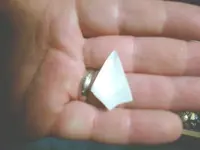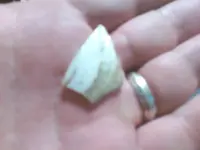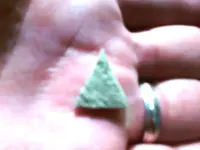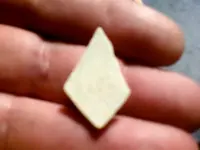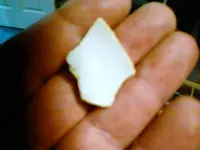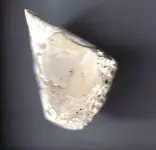Airborne80
Bronze Member
- Joined
- Mar 23, 2005
- Messages
- 1,020
- Reaction score
- 6
- Golden Thread
- 0
- Location
- Northern Virginia
- Detector(s) used
- Whites XLT Classic
Teknetics Delta 4000
- Primary Interest:
- All Treasure Hunting
In my previous posy (the one with the very small bird point) I responded to a comment and spoke about the absence of visible flaking and other marks. I will copy and paste those comments here below, as they pertain to these points that were found yesterday at the exact same spot where the bird point was found. I have many shell (and a few bone) points that were found in the exact same spot that are exact duplicates of these, in terms of size, shape and material. here is the copy of my previous reply on the subject of unorthodox points from my area.
No flaking whatsoever. I am glad you brought that up because while i realize that many folks truly believe that the absence of flaking or other common crafting (knapping) marks translates to an item being a geofact. I honestly (and I stress this in light of what some felt was me disputing them with a negative attitude) honestly honestly understand where that comes from and am not offended or disappointed at all. In fact, the more that I study the archeology of my area, the more interesting this dilemma becomes. I am reading college courses and other material that deals specifically with the very first humans to arrive and live in my area and up to the Historic age of the indigenous people. I have learned that the people who lived, fished and hunted in my neighborhood covered a stretch of time that spanned thousands (maybe as much as 15 to 20) of years, and the artifacts and specifically, projectile points, have not been identified and classified as of yet.
So, items like this one while clearly manmade (I will explain in a second) were not crafted in the way that most of the common and identifiable points were. That mostly has to do with the material that is native to the area. In this case, I am convinced that the stone was not flaked at all but rather ground and shaped against another stone until the desired shape and size was achieved.
The reader must understand the context of the find itself. these items (and I find many of them) are uncovered by the tidal motion of the water at the river's edge. When they emerge, much as the photo depicts, they are never surrounded by other stones of like material, or other material for that matter. They are just as you see this one. A lone perfectly formed triangle made of the exact material that the others are and they are on the banks of the most active fishing site of the particular Indians of my area. In otherwords.... if these were found on a beach that was sprinkled with other rocks and was in a questionable Indian site..... i would (like many) be inclined to label it as a geofact.
Someday soon, I will scan all of the similar points into one photo and it will be clearer to those with an open mind, that the odds of nature placing so many identical items in an area that happens to be a known site.... beyond comprehension. bear in mind, that in other areas that are close to this site, one does not find these items. I will post a point that was made of a clam shell in a moment. I found it yesterday at the same site. I have a number of them and to many, they will not be points at all.... because of the lack of visible flaking,
I hope that this topic is at the least interesting and at the best..... thought provoking in the sense that perhaps we have not discovered all that there is or was on the subject. Happy hunting to all
No flaking whatsoever. I am glad you brought that up because while i realize that many folks truly believe that the absence of flaking or other common crafting (knapping) marks translates to an item being a geofact. I honestly (and I stress this in light of what some felt was me disputing them with a negative attitude) honestly honestly understand where that comes from and am not offended or disappointed at all. In fact, the more that I study the archeology of my area, the more interesting this dilemma becomes. I am reading college courses and other material that deals specifically with the very first humans to arrive and live in my area and up to the Historic age of the indigenous people. I have learned that the people who lived, fished and hunted in my neighborhood covered a stretch of time that spanned thousands (maybe as much as 15 to 20) of years, and the artifacts and specifically, projectile points, have not been identified and classified as of yet.
So, items like this one while clearly manmade (I will explain in a second) were not crafted in the way that most of the common and identifiable points were. That mostly has to do with the material that is native to the area. In this case, I am convinced that the stone was not flaked at all but rather ground and shaped against another stone until the desired shape and size was achieved.
The reader must understand the context of the find itself. these items (and I find many of them) are uncovered by the tidal motion of the water at the river's edge. When they emerge, much as the photo depicts, they are never surrounded by other stones of like material, or other material for that matter. They are just as you see this one. A lone perfectly formed triangle made of the exact material that the others are and they are on the banks of the most active fishing site of the particular Indians of my area. In otherwords.... if these were found on a beach that was sprinkled with other rocks and was in a questionable Indian site..... i would (like many) be inclined to label it as a geofact.
Someday soon, I will scan all of the similar points into one photo and it will be clearer to those with an open mind, that the odds of nature placing so many identical items in an area that happens to be a known site.... beyond comprehension. bear in mind, that in other areas that are close to this site, one does not find these items. I will post a point that was made of a clam shell in a moment. I found it yesterday at the same site. I have a number of them and to many, they will not be points at all.... because of the lack of visible flaking,
I hope that this topic is at the least interesting and at the best..... thought provoking in the sense that perhaps we have not discovered all that there is or was on the subject. Happy hunting to all

Attachments
Upvote
0



